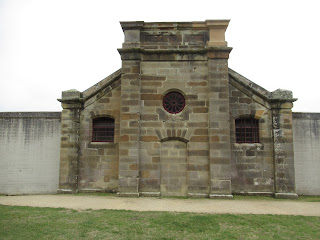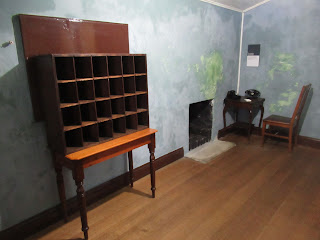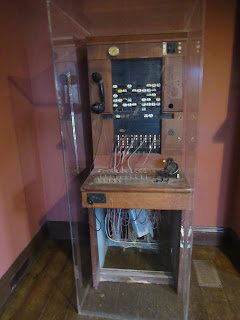I am simultaneously finishing a travel blog about the fantastic 4.5 month long trip Steven and I took last fall and early winter to Armenia, Georgia, Azerbaijan, and much of Central Asia before our final six weeks in Spain and Portugal and a few days in the Netherlands. If you're interested in checking that exciting adventure out, here's the link: www.bergersadventures6.blogspot.com









My friend Diane and I had spent a good chunk of the day exploring the weird but wonderful coastal formations in the narrow strip of land called Eaglehawk Neck that connected the Tasman Peninsula to the rest of the island of Tasmania. South of the Neck was Port Arthur, the state's most popular tourist destination and known as one of the harshest penal institutions anywhere in the world from 1830 to 1877. It was built to house the most notorious prisoners transported from Great Britain, many of whom had escaped from lesser institutions in other parts of Australia. Of the almost 13,000 convicts who spent time at Port Arthur, nearly 2,000 died while in captivity.
Diane and I were so fortunate that we arrived at Port Arthur Historic Site just in time for the last cruise of the day of the harbor that was included in the admission price.
Having grown up in Ottawa, Canada, before meeting Steven in Mexico, I was of course drawn to the sign indicating this was Canadian Cottage! The shop and home was so named because the pre-fabricated cottage was thought to have come from Canada.
It was no surprise the QE II cruise ship seemed to dwarf the little harbor as it was one of the biggest to ever come to this part of Tasmania.
The Port Arthur penal settlement began life as a small timber station in 1830 and quickly grew in importance within the British colonies. The Penitentiary was originally constructed as a flour mill and granary in 1843, before it housed hundreds of convicts in dormitories and solitary cells.
Port Arthur was designed as a maximum security prison as well as to reform convicts by using the island's forests to build large ships. The prisoners learned forty trades and skills constructing the ships. In addition, the guide on the boat mentioned that millions of bricks were made here in the prison era.
A big industry in Tasmania in the early to mid 19th century was whaling. One thousand plus whales were caught in 1839 but just fifty a decade later, according to the guide. Occasionally, he added, whales and seals are still spotted in the harbor.
The Isle of the Dead was where 1,769 convicts and 180 free settlers were buried, mostly in mass graves with only 9 individual headstones. On a guided tour of the settlement after the cruise, the guide mentioned that the small island might hold more graves but archaeologists haven't finished counting yet. As the guide on the boat said, the convicts were "sinners in life and forgotten in death." The richer settlers were buried higher on the island so they would be closer to God.
From 1834-1849, boys from Britain, some as young as nine, were sent "for a better life" or for petty crimes to Point Puer Boys' Prison, just across the harbor from the main Port Arthur Settlement, because they weren't strong enough for hard labor with the other convicts. The boys learned to read and write and were eligible to learn a trade the local settlers wanted. In time, over 3,500 boys spent time on the island, though only 68 were sent initially to the first jail built exclusively for juvenile male convicts in the British Empire. The government later began sending boys to the Isle of Wight off the British coast rather than sending them halfway around the world.
Through the trees, we had a glimpse of the Commandant's House which had a strategic location on the top of the hill overlooking the settlement and the harbor so he could keep an eye on the convicts and products coming in and out of the harbor. Our guide said each room in the eighteen room mansion had been restored to one era in history.
After the harbor cruise, we stopped for several minutes at what has sadly become an all too common memorial. In April, 1996, in what was Australia's worst mass murders, a lone gunman at Port Arthur Historic Site killed 35 people and injured dozens of tourists and staff here at the former Broad Arrow Cafe and at other nearby locations. The tragic events of that day led to new gun control laws that are among the strictest in the world.
The memorial, which opened in 2004, hit Diane and me pretty hard as it came just a few days after we witnessed the police response minutes after the tragedy at the mosques in Christchurch, New Zealand. The memorial, consisting of a peaceful garden and bare walls open to the wind and rain, have become touchstones for people's thoughts about what happened here.
Living in Littleton, Colorado, we both wondered when this madness of mass shootings will ever stop as there have been too many back home and all over our troubled nation.

We then joined the tour of the Port Arthur Historic Site that had around thirty 19th century buildings scattered over a large area. Helen, our guide, said that the entire site was a purpose-built facility to get timber because of its virgin forests that had 300 year old trees. Once the British pushed out the local people, they were then able to claim the land and its resources of timber, coal, clay and sandstone for Britain. Their countrymen began living there and began mining, harvesting and quarrying, all with free labor and free resources. As Helen joked, the Brits must have been dancing quite a jig!
The round guard tower were the barracks for the British Army garrison until 1860.
Once the ships landed in the harbor, the convicts came ashore in the equivalent of a tender and only the fittest were chosen who would be the most productive doing the hard labor required. Those selected were put then put in a chain gang immediately by carrying logs down the mountain.
In what was considered then to be pretty radical prison reform, those in control wanted to incentivize the convicts by rewarding their good behavior, putting them in a new trade to learn with the idea they then could become new and productive citizens. That was the carrot - the stick was the convicts had no idea when they might achieve those goals and be released. Helen indicated the convicts were taught "religious and moral instruction." Over time, Port Arthur was considered to be wildly successful as a means of transforming convicts into full members of society, especially as there had been no expectation Port Arthur would be able to rehabilitate the prisoners.

When the granary was completed in 1845, there was no building anything like that anywhere else in Australia even in the big city of Sydney on the mainland. To power the granary, several treadmills needed to be built using convicts working in 12 hour shifts. Helen said the work had been akin to climbing endless flights of stairs which caused men, decades later, to break down when relating their work on the treadmill.
Helen pointed out the flogging yard where, as a disincentive, all convicts would be trotted out to watch a fellow convict being flogged. If the latter cried out, he would be subjected to harsh treatment by the other convicts when they returned to the barracks and would be known as a 'squealer.' The wooden buildings in the background were built far later.
Unlike any prisons I've seen before, this one had no walls walls as there was literally no place for the convicts to escape to with the settlement being joined to the rest of the island by a narrow strip of land with steep cliffs, a raging surf and guarded by half-starved dogs on the infamous Dogline I wrote about in the previous post.
This Separate Prison was constructed for convicts who didn't behave; they were subjected to very harsh psychological punishment, weren't known by their names but by numbers and heard nothing while inside. The prison was such a silent place that no convict was allowed to speak unless he was addressed by an official. Guards used sign language between themselves. The enforced silence and separation drove men mad living inside 23 hours a day.


The long, spanking clean, brightly lit hallway appeared quite 'normal' and habitable, not what I imagined a prison would have looked like from the mid 19th century. Each cell was furnished with a hammock, table, stool and a cupboard. Too bad it had been so sanitized or 'whitewashed' in the intervening period. Possibly it was pretty snazzy all things considered because anyone entering had to remove shoes because of the wallaby poo in all the open spaces we'd been walking through?


At the end of the hallway was an open space where prisoners were given one hour a day outside.

The punishment cells were reserved for the worst of the worst offenders and were in utter darkness and likewise no sound. This was taken with a flash as otherwise it was pitch black.

Just off the cells was the non-consecrated church that was reached without stepping outside.

For those prisoners that did go mad in the separate prison, an Asylum had to be built next to the prison for the prisoners then referred to as lunatics. The asylum formed part of a new wave of thinking, aimed at curing people with mental disorders by providing "a calm, pleasant and clean environment, kind treatment, exercise and amusement as well as work to occupy and soothe the mind." By 1877, Helen said lots of men who had been physically or mentally damaged were sent to Hobart, the capital of Tasmania. She didn't say what happened to them. Some former prisoners, not from the asylum, later became tour guides as the site became a favorite locale for tourists.
The Government Farm grew just potatoes and cabbages in the early years mostly for the benefit of the convicts' health. In the 1850s, the Farm was established, complete with a cowshed, stable, piggery and dairy.
There were only handful of public servants working in Port Arthur with their families. The Surgeon's House was the first in a line of homes all on the same side of the street overlooking the settlement, just like a row of suburban houses. Certainly not what I'd expected at the Port Arthur Settlement where the prisons and asylum were so close by!
The Roman Catholic Chaplain's Home was built in 1844 specifically for the first priest in Port Arthur after the Roman Catholic prisoners had refused to continue attending Protestant services.
The Junior Medical Officer's Home:
View of the settlement:
The Accountant's Home was built in 1843 to house the Medical Officer responsible for the outlying probation stations. Later, it was was occupied by the officer in charge of the Commissariat stores who acted as the Accountant.
The Parsonage was originally a two-story building built in 1842-3 and gained a reputation as a haunted house during the 1870s when the Reverend Hayward family reported several paranormal events including ghostly apparitions. After considerable damage in the 1895 bush fires, it was rebuilt as a Post Office. Before the phone was connected, messages were sent via Morse Code.
At the end of the street was what remained of St. David's Anglican Church whose foundation stone was laid in 1836 by Lieutenant Governor George Arthur on his final visit to Port Arthur.
Although constructed by the convicts, much of the stonework and paneled pew fronts were prepared by the young boys from Point Puer which means 'boy' in Latin by the way. The church, like the one in the Separate Prison was never consecrated, partly to allow use by several denominations and partly due to disagreements among various church authorities.
These Port Arthur
bells were the oldest chime bells in Australia and believed to be the first
cast in the country. The eight bells were played by a single convict like a
musical instrument with each bell being struck or 'clocked' by a metal clapper
pulled against one inside surface of the bell.
In 1884, sparks from a fire lit to clean up around the Parsonage, caught the old shingles on the church roof and the church was irreparably damaged.
Since it was near the end of the day, it was so quiet and peaceful walking back to the Visitors' Center along the path that was strewn with acorns. We were sure we were going to get beaned by them as they kept dropping all around us the entire walk back!
The Government Gardens, fenced and screened by young oak and ash trees were laid out in 1846 as a place for the ladies of the settlement to 'take exercise' as that was considered an important virtue in the Victorian era.
The Port Arthur Historic Site was recognized by UNESCO as a World Heritage Site in 2010 for its international significance as one of eleven sites in the Australian Convict Sites World Heritage Listing.
Unfortunately, Diane and I were too wiped once we returned to the Visitors' Center to appreciate the Interpretive Gallery which took visitors through the process of sentencing in England to transportation Van Diemen's Land, Tasmania's original name. On entering the center a few hours ago, we'd been given a lanyard with a playing card number on it. It was only in the gallery where we figured out each card represented one of the prisoners who had been sent to Port Arthur or who had been affiliated with the site.
My card represented Alf Mawle, the son of a penal settlement clerk who became a tour guide in early 1900s at Port Arthur.
The map showed the other UNESCO World Heritage convict sites in Australia.
I won't take the time to delve into the types of crimes that were committed by so many men who were then sent from England to Tasmania and other parts of the country. Some were reportedly very minor such as stealing a loaf of bread to feed their families, but others were infinitely more serious. What was important as the Gallery made clear was that in acknowledging the extent of their criminality, it's critical to still recognize the contributions and sacrifices made by Australia's transported convicts. "The key to understanding the country's convict past was to see the convicts as neither saints nor sinners, but rather as a group of people who represented the full spectrum of human experience, many challenged by obstacles on their path to freedom."
Looking back now on the penal system implemented at Port Arthur, it was difficult to see past its cruelties. However, it bears repeating that Port Arthur was founded on an idea that was then very new - that prisoners could be transformed while still being punished. Governor Arthur built on discipline and punishment, classification and separation, religious and moral instruction, trade training and education including classes held several times a week and access to a 13,500 volume library. The measures were to provide convicts with opportunities to become 'useful' future citizens. This sounds ideal, and for those who were able to conform, prospects ensued. For those who couldn't or wouldn't choose reform, though, life was very difficult indeed.
As troubling as it was to learn about the island's history as an outpost for Britain's criminals, it was critical in order to get a better grasp of the country's origins.
Next post: The Convict Coal Mines, Historic Richmond & Hobart's Docks
Posted on the first day of spring, June 21st, 2019, from Memphis, Tennessee, the home of the Blues.
Posted on the first day of spring, June 21st, 2019, from Memphis, Tennessee, the home of the Blues.













































WOW, you got to see the QEII, she certainly gets around. Janina
ReplyDeleteLOVE THE SITE, THE PHOTOGRAPHS ARE FANTASTIC AND THANKS FOR SHARING, CHINA
ReplyDeletechina.alexandria@livingthedream.blog